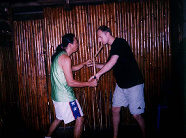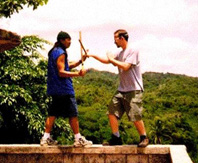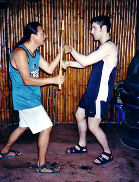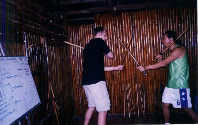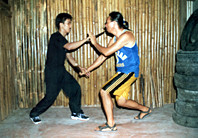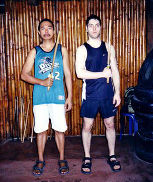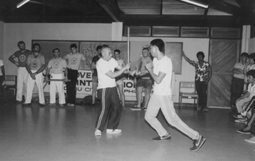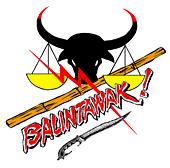 ‘Venancio
Bacon’
or ‘Anciong’ as he was known by his Filipino
nickname, was the first to call his school/club Balintawak, but he was
not initially the major inspiration behind the Cebu Escrima movement.
To find the beginning
of the Balintawak school, you must look at the early twentieth century
innovators and originators of the collective, Arnis/Escrima movement in
Cebu.
‘Venancio
Bacon’
or ‘Anciong’ as he was known by his Filipino
nickname, was the first to call his school/club Balintawak, but he was
not initially the major inspiration behind the Cebu Escrima movement.
To find the beginning
of the Balintawak school, you must look at the early twentieth century
innovators and originators of the collective, Arnis/Escrima movement in
Cebu.
One of the first major Escrima schools in Cebu was the ‘Labangon Fencing Club’ of the 1920's. The Saavedra family, especially Lorenzo Saavedra and his nephews Teodoro and Frederico Saavedra and the older Cañete brothers were the main influence and force behind it. Venancio Bacon was one of the Saavedra's students and also, was a close family friend.
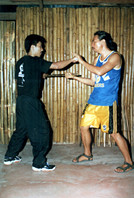 During
the 20's, because of what some say was due to political infighting between
members
During
the 20's, because of what some say was due to political infighting between
members
and through a general lack of interest by some, the Labangon club folded.
Later in 1932 the Saavedra's and Cañete's became founding members of another
Escrima club, the now famous, 'Doce Pares'.
The new club being made up of some of the old Labangon club members are
said to have wanted to try and forget the past and de-localise the name
of their new club, by not using the old name of 'Labangon'. Labangon is
a suburb of Cebu and it's loose translation into English is something
akin to 'A bridge over running water'. The members wanted to give the
club a more regional appearance with a more dramatic, recognisable name.
Some older Escrimadors from Cebu, from their point of view, believe the
older club simply evolved and adopted the new name 'Doce Pares'.
In World War Two the Saavedra family was all but wiped out by the Japanese and after the war the Escrima school was far from the remaining Saavedra family members minds. One family group developed the leading major role in the Doce Pares. A political division broke out, with this family and the deceased families instructors and students. ‘Anciong Bacon', one of these disgruntled instructors, due to personal and political reasons, decided to break away and opened his own club. He opened his first gym in Balintawak street in Cebu City in 1951.
|
|
The term ‘Balintawak’ refers to an area in Luzon where in 1896 a successful revolt and battle took place against the Spanish. Balintawak was later used by other Filipinos during different battles as a war cry, so Venancio thought it fitting that his new club should be named after the street where his club was located and the patriotic symbol and battle cry of the warriors of his country. Venancio was expert in several styles of Escrima, and was also skilled in Boxing, Filipino grappling or ‘Dumog’ and Jui Jitsu, which is referred to by some Filipinos as ‘Combat Judo’. He reasoned that by combining the theories and concepts of these different styles of fighting a very rough and effective form of Martial Art could be produced. His style of teaching however was quite different from the way some Balintawak schools teach today. Anciong’s style had no clear lines of instruction, his students were taught techniques and fighting principles at random. One of Venancio’s successors to Balintawak was a Lawyer called 'Attorney Jose Villasin'. He set about to ‘systemise’ and ‘group’ the style into its various categories so that his students could master one set of related techniques and then move onto the next set of related techniques. This is the juncture where several distinct schools of Balintawak emerged. Many of Venancio’s Balintawak students and some of Venancio’s and the Saavedra's older Doce Pares students continued to teach in the old style of random instruction, while Attorney Villasin’s family and close friends/students used his unique ‘grouping’ method. |
|
One of Venancio’s
successors to Balintawak was a Lawyer called 'Attorney
Jose Villasin'. He set about to ‘systemise’
and ‘group’ the style into its various categories so that his
students could master one set of related techniques and then move onto
the next set of related techniques. This is the juncture where several
distinct schools of Balintawak
emerged. Many of Venancio’s Balintawak students and some of Venancio’s
and the Saavedra's older Doce Pares students continued to teach in the
old style of random instruction, while Attorney Villasin’s family
and close friends/students used his unique ‘grouping’ method.
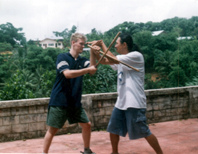 Some instructors from
the different instructional styles state the grouped method is ‘modified’
Balintawak. This is not so. The techniques and principles of Grouped Balintawak
have not been made different in form, restricted, varied, or limited in
any matter and have been observed to be still, all the same. It is simply
the ‘method of teaching’ that has been examined and refined.
Even
Some instructors from
the different instructional styles state the grouped method is ‘modified’
Balintawak. This is not so. The techniques and principles of Grouped Balintawak
have not been made different in form, restricted, varied, or limited in
any matter and have been observed to be still, all the same. It is simply
the ‘method of teaching’ that has been examined and refined.
Even 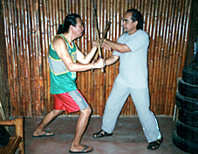 some
older Doce Pares Grandmasters (whom we have had the privilege to have
trained with), whose lineage comes from Bacon and/or the Saavederas all
have the same style and moves, (if their instructor had any length or
high degree of training) but they simply do not have the same teaching
system.
some
older Doce Pares Grandmasters (whom we have had the privilege to have
trained with), whose lineage comes from Bacon and/or the Saavederas all
have the same style and moves, (if their instructor had any length or
high degree of training) but they simply do not have the same teaching
system.
Another Balintawak student of Venancio and then instructor for Venancio, Timoteo E. Maranga formed his own school of the 'Super Kuwentada Escrima System' ('Kuwentada' or 'Cuentada' or counting as it translates into English was a name Venancio sometimes called his style) and taught in the special regimen of his own school. Most of Attorney Villasin’s family and close friends/students however used Jose's unique grouping method.
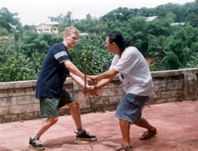 One
student of Attorney Villasin’s was 'Teofilo A. Velez' (Teovil
or Filo). He formed his own club and began to teach but while Attorney
Villasin only taught privately to close friends and relatives Teofilo
opened his club to the general public.
One
student of Attorney Villasin’s was 'Teofilo A. Velez' (Teovil
or Filo). He formed his own club and began to teach but while Attorney
Villasin only taught privately to close friends and relatives Teofilo
opened his club to the general public.
There are now a number of Balintawak schools scattered throughout the Philippines as well as Australia, Canada, Europe, New Zealand and the U.S.A. Some of these Balintawak schools are from both methods of random instruction and grouped instruction. All of these schools have the right to call themselves Balintawak, if they or their instructors can trace their instruction back to Venancio Bacon. The Visayan Martial Arts school teaches both the grouped method of instruction of Balintawak as taught by Teofilo A. Velez and the method of instruction of Timoteo Maranga's form of Balintawak.
|
|
Teofilo Velez and Henry Jayme demonstrating
at the Arnis-kali-Escrima !st World Instructors Seminar in Cebu City, August 1987.
Video of the Balintawak section of the Arnis Escrima Kali 1st World Instructors Seminar of 1987 was received in 1998. It's old video but those that were there may be interested. See if you can see your face in the video freeze frame captures. Go to the Rare Video Balintawak page to see these captures.
Back to the Balintawak index page
| Home | seminars | balintawak | doce pares | tat kun tao | VMA instructors | travel pics | articles | FMA instructors | downloads | email | links |
©1998-2003 John Russell
